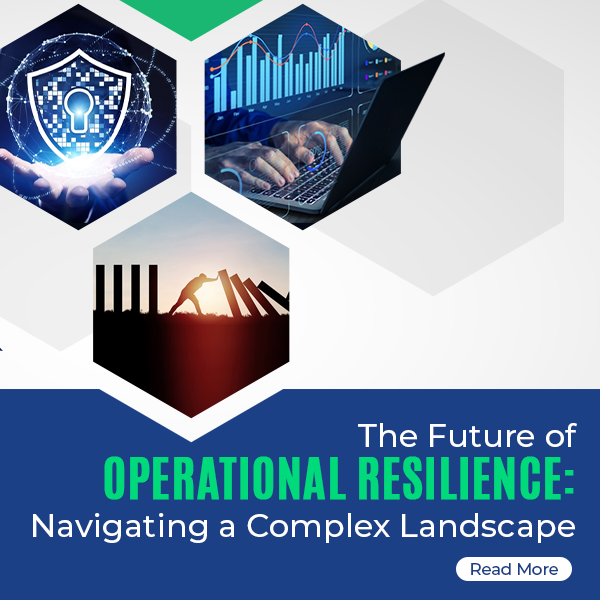In a time of swift technological progress, unpredictability in world events, and a constantly changing business environment, operational resilience has emerged as a crucial component of successful organizational operations. It is more important than ever to be able to adjust, tolerate setbacks, and carry on with business as usual when faced with difficulties. Looking ahead, it’s clear that operational resilience will remain a key component for companies looking to achieve long-term success.
The Current Landscape
Let us first examine the existing condition of operational resilience before moving on to the future. Businesses encounter a wide range of difficulties, from pandemics and supply chain disruptions to cyberattacks and geopolitical unpredictability. The conventional method is no longer sufficient; we need a more thorough and dynamic approach to risk management.
The concept of operational resilience stresses the capacity to adjust and prosper in the face of interruptions, going beyond risk minimization. It includes supply chain dynamics, organisational culture, regulatory compliance, and cybersecurity, in addition to technology.
The Aspects of Operational Resilience: A Multifaceted Analysis
Operational resilience is a complex concept that requires a multifaceted analysis, considering various aspects that influence its trajectory. In this exploration, we’ll delve into the Human, technological, climate, financial, cultural, and regulatory aspects of operational resilience.
The Human Element
Even though technology is a strong ally, operational resilience still heavily depends on people. Equipping workers with the right skills is just one aspect of creating a resilient organizational culture; another is encouraging a flexible mentality that allows for situational adjustments. Preparing the workforce for unforeseen difficulties requires a combination of critical components, including communication strategies, scenario exercises, and training programs.
Technological Aspect
Technology can be both a help and a hindrance in the field of operational resilience. The instruments and processes in place now are essential for detecting and reducing hazards. Artificial intelligence, automation, and advanced analytics all support proactive response mechanisms and real-time risk assessment. Dependence on advanced technologies, however, brings with it a new set of risks, especially with regard to cybersecurity.
Climate Aspect
The environmental, ecological, and socioeconomic contexts strongly influence operational resilience. For instance, extreme weather occurrences can disrupt supply chains, impacting production and distribution. Ecological considerations, such as resource scarcity or environmental regulations, may compel organizations to reassess their operational strategies. Socioeconomic factors, including the economic stability of a location, influence resources and skilled labour. Incorporating climate risk assessments into strategic planning is crucial for organizations to enhance operational resilience and ensure global adaptation.
Financial Aspect
The economic consequences of operational resilience are significant. In the long run, the benefits of resilience measures far outweigh the associated expenses. Organisations that are resilient can withstand shocks more effectively, reducing losses and preserving their competitiveness in the market. Conversely, a lack of resilience can result in significant economic downturns that impact entire industries as well as individual enterprises. Working together, companies and governments can provide financial rewards for promoting operational resilience, seeing it as an investment in long-term economic stability.
Cultural Aspect
Culture both shapes and is shaped by operational resilience. Cultural variables have a significant impact on organisational ideals, staff attitudes, and consumer behaviour. Businesses may be more likely to implement eco-friendly practices in areas where sustainability holds cultural significance, as this might strengthen their ability to withstand shifting community expectations. Comprehending cultural subtleties is essential to customizing resilience tactics that appeal to both local communities and international stakeholders.
Regulatory (Governing Regulations) Aspect
The terrain of operational resilience is significantly shaped by governing regulations. Not only is adherence to laws, regulations, and industry standards required by law, but it is also a vital component of resilience building. Forthcoming regulatory frameworks will probably exhibit increased stringency, namely in domains like cybersecurity and data protection. To make sure that their operational resilience plans comply with the law, organizations must stay up-to-date on the latest changes to legislation. Businesses and regulators working together can create a more secure and resilient business environment.
Key Takeaway
The dynamic and diverse nature of operational resilience in the future calls for a comprehensive strategy that integrates human capital, technology, and strategic foresight. Strong supply chains, a resilient culture, technological investment, and acceptance of change are all crucial elements of a successful operational resilience plan.
Operational resilience becomes a survival need in a world where volatility is the only constant. It is not merely a business strategy. Organizations that prioritize and invest in operational resilience will not only withstand crises but also emerge stronger and more adaptive than ever before as we negotiate the complexities of the future.
Our resilience management platform, “AutoResilience“, is industry-leading and has four modules for risk, crisis, business continuity, and cyber resilience. Many banks worldwide have relied on us, endorsed by analysts such as Gartner and Forrester, to minimize disruptions, meet regulatory standards, and protect their reputations.













